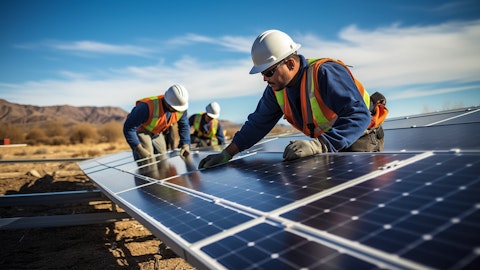Genie Energy Ltd. (NYSE:GNE) Q2 2025 Earnings Call Transcript August 8, 2025
Operator: Good morning, and welcome to the Genie Energy Limited’s Second Quarter 2025 Earnings Call. In today’s presentation, Genie Energy management will discuss Genie’s financial and operational results for the 3 months ended June 30, 2025. During prepared remarks by Genie Energy’s Chief Executive Officer, Michael Stein; and Chief Financial Officer, Avi Goldin. [Operator Instructions]. After Avi Goldin’s remarks, Michael and Avi will take questions from investors. Any forward-looking statements made during this conference call, either in the prepared remarks or in the Q&A session, whether general or specific in nature, are subject to risks and uncertainties that may cause actual results to differ materially from those which the company anticipates.
These risks and uncertainties include, but are not limited to, the specific risks and uncertainties discussed in the reports that Genie Energy files periodically with the SEC. Genie Energy assumes no obligation either to update any forward-looking statements that may have made or may make or to update the factors that may cause actual results to differ materially from those that they forecast. In their presentation or in the Q&A session, Genie Energy’s management may refer to non-GAAP measures, including adjusted EBITDA, non-GAAP net income and non-GAAP earnings per share. A schedule provided in the Genie Energy’s earnings release reconciles adjusted EBITDA, non-GAAP net income and non-GAAP earnings per share to the nearest corresponding GAAP measures.
Please note that the Genie Energy earnings release is available on the Investor Relations page of the Genie website. The earnings release has also been filed on Form 8-K with the SEC. I will now turn the conference over to Michael Stein. Sir, the floor is yours.
Michael M. Stein: Thank you, operator. Our second quarter yielded mixed results. On the one hand, it was highlighted by solid operational progress and double-digit top line growth. On the other hand, our bottom line was impacted by significant margin compression at GRE, which weighed on our bottom line results. At GRE, we expanded our customer base in the second quarter to approximately 419,000 meters served, comprising approximately 414,000 RCEs, representing a year-over-year increase of 15% and 20% in meters and RCEs, respectively. Churn in the second quarter dropped to 4.8% from 5.5% in the first quarter, and I think, we can and will continue to make progress as we further improve our customer retention operations. GRE’s bottom line, however, was impacted by wholesale power price increases in some of the supply markets, most notably within the PJM and MISO interconnection zones.
The volatility in the quarter was driven by policy concerns and by warmer-than-usual weather, particularly in June. There have been times over the past few years where wholesale price volatility has led to margin upside for the company. However, this quarter, the impact was against us. GREW delivered very strong results. Revenue increased 44% and the segment approached breakeven even as we invested in some of our newly developing businesses. At Diversegy, our brokerage and energy advisory business, revenue increased year-over-year by over 50% and profitability increased by almost 3,000%. At Genie Solar, revenue jumped over 6x the year ago level to $1 billion, reflecting a solid quarter from its portfolio of operating arrays and the bottom line loss decreased by 90% as we also significantly reduced SG&A.
Turning now to Genie Solar’s development pipeline. We are making good progress on the more advanced projects, including our Lansing Community Solar project, which I’m excited to say we expect to commission in the third quarter. Meanwhile, we have paused work on several of the earliest stage development pipeline projects to reevaluate their economics in light of recent changes in the development landscape. On the one hand, we anticipate unprecedented demand for power from data centers and industry in the coming years. On the other hand, the accelerated sunset of solar generation tax incentives included in the recently enacted federal tax and budget legislation, the One Big Beautiful Bill will impact a few projects at the tail end of our current pipeline that are in the earliest stages of development.

We are currently working to gauge the impact of those changes on these early-stage projects and determine whether and how it makes sense to move ahead with them. Also, because of the legislation, we are pausing efforts to add projects to our development pipeline. Also within GREW, we continue to invest carefully in promising initiatives outside of the solar generation space. Most notably, we have had early success leveraging our insurance capabilities and marketing expertise to offer tailored insurance products to retail customers. We are also optimistic about [indiscernible] , our majority-owned venture utilizing recycled plastic waste to make pallets and other products. We hope to have more to share about both businesses in the coming quarters.
Turning back to Genie on a consolidated basis. During the second quarter, we again returned value directly to our shareholders by repurchasing approximately 159,000 shares and paying our regular quarterly dividend of $0.075 per share. Looking ahead to the balance of the year, we are expecting GRE’s margins to return closer to historical levels. Assuming a normalized commodity environment and with continued improvement in growth at GREW, we confirm Genie’s 2025 consolidated adjusted EBITDA guidance at $40 million to $50 million. Now here is Avi.
Avi Goldin: Thank you, Michael, and thanks to everyone on the call for joining us this morning. My remarks today cover our financial results for the 3 months ended June 30, 2025. In my commentary, I will compare the results for the second quarter of 2025 to the second quarter of 2024 to remove from consideration the seasonal factors that impact our results, particularly within our retail energy business. Second quarter is typically characterized by relatively low levels of electricity and gas consumption as it falls mostly between the first quarter’s peak heating season and the third quarter’s peak cooling season in many of our service areas. Our second quarter financial results were headlined by a challenging pricing environment in the retail energy business, we experienced higher-than-usual costs leading to margin pressure.
Consolidated revenue in the second quarter increased 16% to $105.3 million, driven by growth at both Genie Retail and Genie Renewables. At GRE, revenue increased 14% to $99 million in the second quarter, reflecting the year-over-year growth of our customer base that Mike will detail for you. Per meter consumption was roughly in line with year ago levels. Electricity revenue climbed 15% to $89.9 million, representing 91% of GRE’s revenues. Kilowatt hours sold increased by 17%, while our revenue per kilowatt hour sold decreased to 2%. Natural gas revenue increased 8% to $9.1 million. Therm sold increased 5%, while our revenue per therm sold increased 3%. At GREW, second quarter revenue increased 57% to $6.3 million. The revenue increase was led by continued strong growth within our retail brokerage and advisory service, Diversegy, and at Genie Solar.
Consolidated gross profit decreased 30% to $23.5 million, while gross margin decreased 1,400 basis points to 22%. At GRE, gross profit declined 34% to $21.3 million, reflecting increases in our wholesale electricity and natural gas costs. Our cost of electricity per kilowatt hour sold increased 20% compared to the year ago quarter, particularly within the PJM and MISO interconnection zones. Our cost per therm of gas also increased up 52% year-over-year, albeit on relatively low consumption levels. Consolidated SG&A decreased 4% to $21.2 million on reduced payroll and customer acquisition expense. Consolidated income from operations for the quarter came in at $2 million with adjusted EBITDA of $3 million, down from $9.5 million and $12.5 million, respectively, in the second quarter of 2024.
The declines were primarily driven by the reduced gross profit at GRE that I discussed earlier. At GRE, income from operations decreased 73% to $4 million and adjusted EBITDA decreased 74% to $4.4 million. At GREW, the second quarter loss from operations narrowed to $181,000 from $1.4 million in the year ago quarter, while adjusted EBITDA improved from negative $1.1 million to negative $97,000. The improvements were driven by accelerating profitability at Diversegy and a narrowing loss from Genie Solar. Consolidated net income attributable to Genie common stockholders was $2.8 million or $0.11 per share compared to $9.6 million or $0.36 per share a year earlier. Turning now to the balance sheet. At June 30, 2025, cash, cash equivalents, long and short-term restricted cash, which includes cash held by our tax insurance subsidiary and marketable equity securities totaled $201.6 million.
Working capital was $115 million. Our net current and noncurrent debt totaled $9 million, primarily from the financing of our solar portfolio. We repurchased approximately 159,000 shares of our Class B common stock in the second quarter for $2.7 million and paid our regular quarterly dividend, returning $4 million in value to our stockholders so far this year. Wrapping up, despite the challenging pricing environment within retail, the underlying business fundamentals remain strong. We are well positioned for the remainder of the year and expect to meet our full adjusted EBITDA guidance of $40 million to $50 million, assuming normalized weather conditions. Operator, back to you for Q&A.
Q&A Session
Follow Genie Energy Ltd. (NYSE:GNE)
Follow Genie Energy Ltd. (NYSE:GNE)
Receive real-time insider trading and news alerts
Operator: [Operator Instructions] Our first question is coming from [ Syed Zaid ], who is an investor. There appears to be nobody available on that line. We have a question from [ Scott ] who is a private investor.
Unidentified Analyst: Two questions. The first one, what gives you hope or confidence that your retail margins or rather your wholesale margins will return to normal? Obviously, the world has changed quite a bit over the last 6 months, and this is a relatively tough quarter for Genie. So maybe starting with that one, what gives you hope that your margins will return close to normal and reaffirming your guidance for the year?
Unidentified Company Representative: Thank you for the question. So our margins were hurt in the quarter by definitely some political factors, but I think mostly by weather. It has been a particularly hot end of spring and beginning of summer, which kind of pushed prices higher. We think things are starting to calm down on the wholesale front, and that’s what gives us confidence that we should be able to pull off our guidance.
Unidentified Analyst: So it’s really just a hope on weather. Are there any hedging strategies or trading strategies you could take and hope on weather is not a great strategy.
Unidentified Company Representative: So typically, the way we hedge, we hedge our business at a very high percentage, meaning we hedge out our expected load at a very high percentage, and it’s just kind of a small percentage that we — that could vary depending on very, very — depending on weather. So there is some that is definitely out of our control. But by and large, the highest percent — the vast majority of our power is already purchased.
Unidentified Analyst: So how are the margins — I guess I’m just a little — not depressed, but I’m a little confused then how does weather impact your margins so significantly if you’re materially hedged. [indiscernible] amount make that big a difference?
Unidentified Company Representative: Yes. So if weather is significantly different than historicals, then even that, call it, 15% to 20% can make a very big difference in the margins. And that’s what happened to us over the last few months and how the market obviously reacts to the fact that it’s very hot. So when it’s very hot early in the season, typically, what you see is that the rest of the season or typically — sorry, when it’s very hot in the beginning of the season, the wholesale markets react in an uncertain kind of a way. But when you see heat toward the end of the season or when you expect to see that heat, usually, the market doesn’t react as much as it did in the beginning of the season. So we feel pretty confident that the amount that we hedged and given that we’re already in kind of middle toward the end of the summer where people expect the heat, we should be in good shape.
Unidentified Analyst: Okay. Got it. And then just on your solar projects, is there a viable path for new solar projects today, I understand the pause as everybody sorts through it. And maybe 2 questions on the solar. What’s the amount of capital that’s locked up in those projects that may not go forward as a potential loss? And is there a growth path currently without the tax credits?
Unidentified Company Representative: So very little capital is locked up in the new projects. Generally, the way these projects work is that the development part where you’re trying to get permits, interconnection approvals, engineering viability is the amount you spend on that is a very, very small percentage of the overall total spend on the project. Probably 95% of what you spend on the project is once you start construction. So very little capital is tied up in projects that we are not viable. In terms of new projects, like I said, we’re pausing. We’re trying to figure out if there is a path forward for future projects that have a time line that goes beyond when the Big Beautiful Bill dictated that the ITC credits go away. And we’ll obviously be able to update you when we make those determinations.
Operator: Our next question is coming from [ Jim Hayden ] who is a private investor.
Unidentified Analyst: My question is around the captive insurance subsidiary. Just starting at a high level, how would you summarize performance there, that’s policies sold or revenue or profit? What’s generally the investment mix? And how does that compare — both of those things, how does that compare to your expectations a few years ago?
Unidentified Company Representative: We’re very, very conservative with how we manage the cash in the captive, mostly sits in cash. We have a little bit in alternative investments. It’s doing just fine.
Unidentified Analyst: And what lines are you selling? And what’s — my understanding this is a revenue opportunity, not just maybe a captive, it’s for cost savings for employees. Is that accurate? And how are you — what are you actually selling as far as lines of insurance?
Unidentified Company Representative: We are starting — we just started. It’s still very early, as I alluded to in my remarks, but we are doing some health insurance sales, leveraging our existing marketing channels to sell some health insurance.
Unidentified Analyst: Is there any plans to expand from that?
Unidentified Company Representative: Yes. We’re still in early stages. I don’t want to say what yet, but the plan is to get into more. But to be clear, the captive insurance at this stage is not underwriting the actual insurance risk behind those health insurance plans. Right now, we are acting as a broker. There is a possibility that, that will change at some point. But it will — I think it will be a few years before we do something like that.
Operator: As we have no further questions on the lines at this time, this will conclude today’s call. You may disconnect your lines at this time, and have a wonderful day, and we thank you for your participation.
Follow Genie Energy Ltd. (NYSE:GNE)
Follow Genie Energy Ltd. (NYSE:GNE)
Receive real-time insider trading and news alerts



